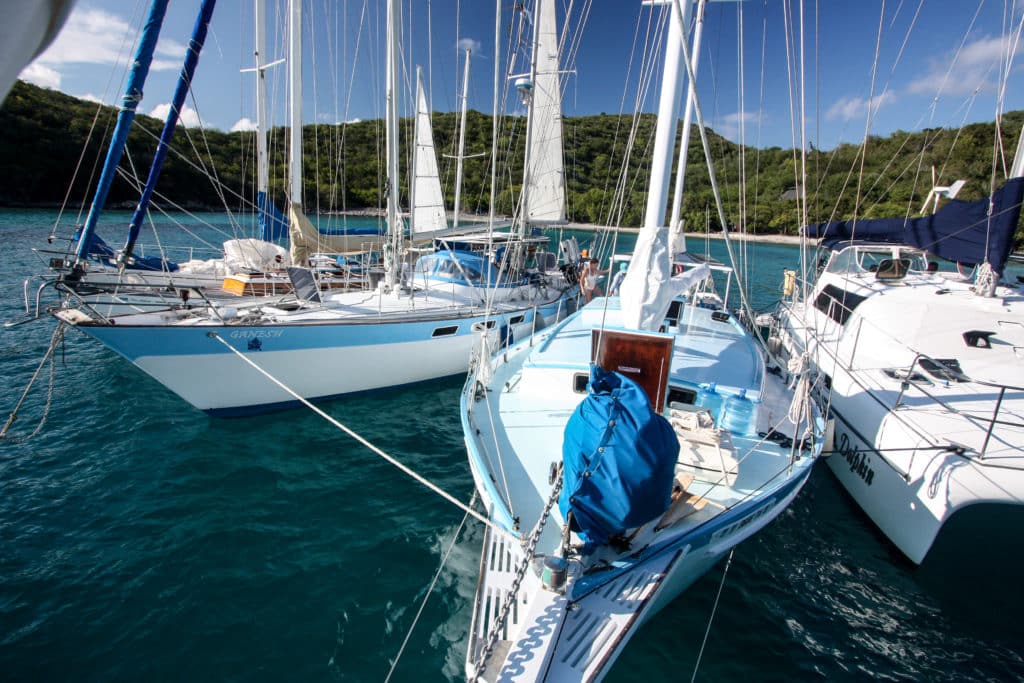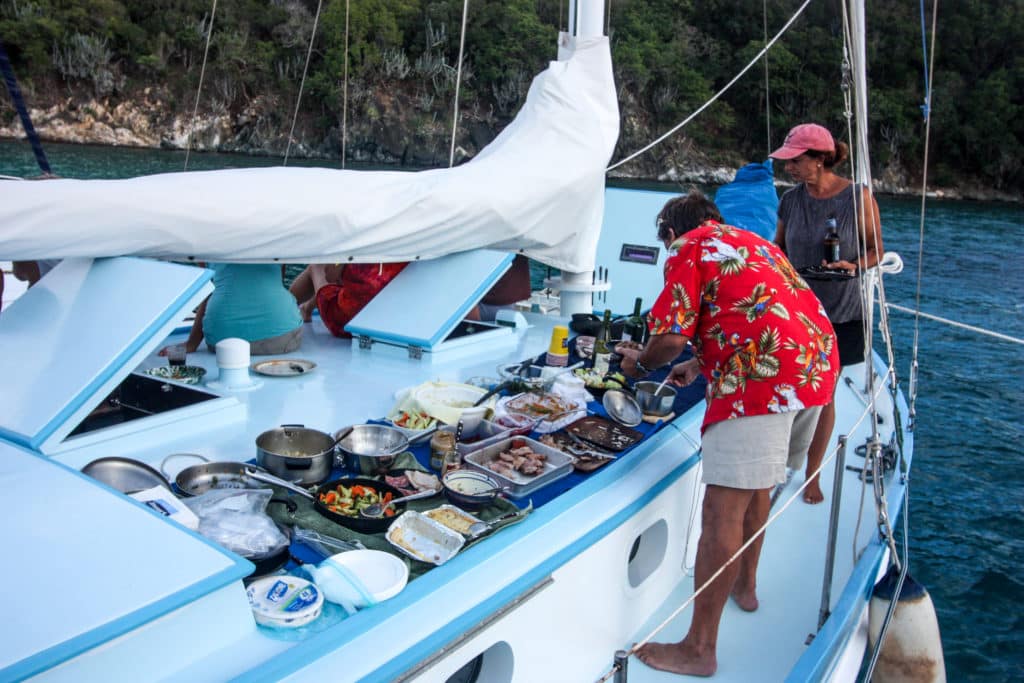
May I speak bluntly? Of course I can. If you’re going to gather together a hundred or so sailors on a dozen boats on Thanksgiving Day with the specific goals of 1) eating too much, 2) drinking too much and 3) laughing too much, then you best do it properly.
Of course, there is the option not to raft up. This makes sense from a seamanship perspective, but not from a social one. I love a large gathering where I endlessly stroll from sailboat to powerboat to sea-spider racing trimaran, not only to check out the various vessels and their gear but to run into enclaves of nudists, animal-rights advocates, parents, herbologists, gaffers, kitesurfers, home-schoolers, scuba divers, Frenchies, revolutionaries, bread-makers, wood butchers, anarchists and writers, all tucked into aft cabins and forepeaks, on swim ladders, sitting on booms, gathered in cockpits and just strung out on happiness along the side decks.
Thanksgiving is my favorite holiday. Christmas has grown too commercial, and New Year’s is amateur night for folk who don’t know how to drink. While I like the edginess of Halloween, there are too many razor blades in apples for me to relax. Thanksgiving, however, is just a glorious food orgy of good vibes. I look forward to the gluttony all year.
OK, that’s my party-animal side. The other part of my personality is the technical sailor who knows that if you want to get stupid with lots of people, you’d best think it through prior to playing macramé with the actual boats. Let’s get some basics down: Each vessel should tie four fenders on each side, have its anchor gear ready to deploy, and have four nylon dock lines with chafe protection ready to run.
Why should all vessels have their anchors ready when most will not need to deploy them? So the raft can break up at a moment’s notice, at anyone’s request. Basically, that’s our rule. Anyone can raft up, but only if they can cast off in a heartbeat. Obviously, this means each vessel has to have a designated skipper.
Why nylon line? It makes a huge difference in noise compared to Dacron. Plus nylon dock lines will be much kinder when led over varnished cap rails. We love varnish and have no desire to kill it.
Why so many fenders? Obviously, all the boats are going to have to tie up to each other, so the more fenders, the merrier. In addition, having a giant tri, two catamarans, a schooner, three ketches, two yawls, and a dozen sloops and cutters rafted together draws attention. Invariably, at some point a 60-foot Donzi will roar by at high speed, see the raft-up and decide to check it out, dude! The rafted vessels must be ready to handle a sizable broadside wake in addition to any squalls that might blow through.
Here’s where it gets a little delicate. Chances are that there are going to be boats with various sorts of gear and skippers with various levels of expertise. Thus, well before the event, you need to pick the proper center boat. This boat needs to have a good anchor, rode and windlass, as well as a nonintoxicated, nonstoned skipper.
This boat should arrive early (perhaps even the day before), in a spot with plenty of room if the wind should shift, and put out at least 8-to-1 scope for its anchor. Why so much? We’ll get to that.
In our annual Thanksgiving raft-ups in the U.S. Virgin Islands, we used the schooners Liberty or Cassiopeia, or Capt. Dave Dostal’s lovely 56-foot yawl Rob Roy. In a pinch, we’d go with Lon Munsey’s Flying Circus, even if hanging off a wooden vessel more than 100 years old was a bit daunting.
Next we’d pick a few smaller vessels, say Thatcher Lord’s yawl Trinka and Larry Best’s graceful U.S. Coast Guard Academy yawl Osprey, for our wing boats rather than have these lovely boats raft alongside the center vessel. To begin the raft-up, we liked having all the boats gather around noon. Since we were doing this in the U.S. Virgins, chances were very good that the wind would be from 112 degrees to 118 degrees and not falter. Predictable conditions are a real plus.
The larger boats (without the best gear) rafted on each side of the center boat. In theory, four vessels would raft up to the center boat, two on each side. At that point, the wing boats deployed anchors 45 degrees from the raft-up, dug them in, drifted back and then pulled themselves sideways into the raft.

With the wing boats tied in place, we’d have a raft of seven boats hanging on three large anchors — one directly forward, and the other two spread out at 45-degree angles. We would adjust the rodes so the center boat always took up first and then the side boats. This meant we not only had a very wide and stable stance, but the vessels got slightly pulled apart in any sizable gusts.
This approach to a raft-up is a bit tricky to imagine, but it is easy to do. In fact, with a seven-boat raft and a steady wind, it’s possible to stay rafted together for days without getting any pressure on your fenders if you’re OK with a long step in between vessels.
Needless to say, when tying off the boats, you have to look aloft because masts must be staggered. I’ve been on rafts that resulted in broken spreaders and entangled rigging because the locations of the rigs weren’t properly considered.
At night, in the Caribbean at least, sometimes the trade winds die for a couple of hours after midnight. Thus our center boat often deployed a light aluminum Fortress anchor off the stern to keep the whole raft from spinning. (It would be deployed after everything else was in place so it couldn’t get caught in a prop while maneuvering.)
The beautiful part of this arrangement was that if a large, violent squall was sighted, within moments the boats on either side of the center boat could cast off and the wing boats could dump out more scope, while the center boat reduced its scope from 8-to-1 to 6-to-1. Instantly, you had three smaller rafts, equally and safely spaced.
What if more people and boats show up? Here, again, this arrangement shines. If the wing boat casts off its springs and aft line from the boat closer to the center of the raft, both boats can pull away from each other by easing their bow lines. The new arrival, meanwhile, can pull into the just-created “slip” between the vessels as easy as pie (pumpkin is my fave, although I love blueberry and apple too).
Any multifreaks or yacht racers who might show up at the last minute can temporarily hang off the side boats because their vessels are usually light in weight and won’t stay long. (Multifreaks, I should explain, are multihull speedsters, folks who refer to our monohulls as lead mines or sea slugs. Yes, we seek revenge by taunting, “I’m not sure I want to go offshore in any vessel that needs to be stamped ‘This side up’ at the factory!”)
When rafting, dinghies can be a problem, especially when the motherships have outboard rudders, boomkins and self-steering vanes, the latter of which don’t like to be tapped even slightly, let alone have a Boston Whaler get caught under them during a large wake.
One solution, if someone is just stopping by, is to allow the “Sure, we’ll have a beer” speedboat to drift aft on a very long painter. This can work fine or end in disaster, depending.
A safer solution is to anchor a dinghy astern and off to one side of the raft-up. Since everyone will be swimming throughout the day anyway, direct all extra dinghies there, especially rigid ones with iffy rub rails. (There’s always a teenager in the water who will happily swim a dinghy back if you don’t want to get wet.)
Another factor to consider is landlubbers. Since we did our Turkey Day raft-ups on St. John, many of our best friends used to be intelligent — oops, I mean used to be sailors — and have now swallowed the hook. So we liked locations convenient to a beach so we could ferry these folks back and forth at predetermined times.
We used to do this in the national park until it installed for-profit moorings and nixed the practice. After that, we gathered in Round Bay, on St. John’s East End, which was hassle-free, close to a number of beaches, and didn’t get a wind swirl or backwind during our normal trade-wind conditions.
Now, a bit of advice once the food arrives: Don’t get lax and allow conversation to distract you. Wolf down your meal and immediately tack back into the crowd for seconds, thirds and fourths. If you don’t make your move quickly, there is a danger you’ll get slowed up by the gluttons. Yes, you can use your elbows and hips on your fellow sailors, just go easy on any elderly guests or crawling infants.
If your tummy hurts the following day and there are no scratches on your topsides — you did it right.
– – –
The Goodlanders spent this past tropical-storm season in Grenada, where on Thanksgiving Day, they hoped to give thanks for having survived hurricane season, and to say a prayer for all their less fortunate cruising buddies.








